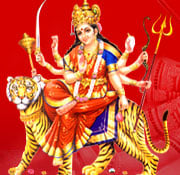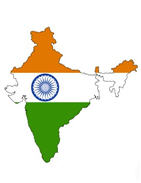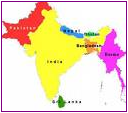Watch this video to help you decode the mysteries of the complicated Indian head nods and bobs.
 “A lot of people might find it strange,” says Paul Mathew. “But if you are born in India, as you grow up, it becomes a part of your character, your personality, that as you talk you tend to move your head in different ways.” Mathew, originally from south India but now working in the film industry in Mumbai, is the writer and director of Indian Headshakes – What Do They Mean? which has garnered more than a million views on YouTube since it was uploaded last week.
“A lot of people might find it strange,” says Paul Mathew. “But if you are born in India, as you grow up, it becomes a part of your character, your personality, that as you talk you tend to move your head in different ways.” Mathew, originally from south India but now working in the film industry in Mumbai, is the writer and director of Indian Headshakes – What Do They Mean? which has garnered more than a million views on YouTube since it was uploaded last week.
“If we had known that this video was going to get such awesome viewership we would have shot it better,” he says. Read more on the links… and in our latest book, The Diversity Dashboard here.
guest |
October 16th, 2012
Navaratri, one of the greatest Hindu festivals, begins today. Navaratri means ‘nine nights’ in Sanskri. The celebration symbolises the triumph of good over evil and the festivities last for nine days. Navratri takes place at the beginning of October around harvest time.
Navaratri means ‘nine nights’ in Sanskri. The celebration symbolises the triumph of good over evil and the festivities last for nine days. Navratri takes place at the beginning of October around harvest time.
Most Hindus fast during Navaratri and only have a single meal during the day. Despite the fast, food is very important in Navaratri and there are many special Navaratri dishes such as banana chips and aloo raita. Fruits and dairy dishes are very popular, whereas non-vegetarian food is totally avoided during the celebrations. The internet offers several Navartri food and cooking guides. For this year’s Navaratri, India Today suggests a range of “mouth-watering twists” to tradition recipes, that will turn the “fast into a feast.”
Read more.. »
Taking place during the Hindu month of Sravana (13th August 2011),
Raksha Bandhan is a very beautiful and important festival. It celebrates brotherhood and love, promoting harmonious coexistence between all. It is mainly celebrated in Northern India. Raksha Bandhan is a significant event in the Hindu Calendar and the importance of the brother-sister relationship is emphasised throughout.
Read more.. »
Every day it seems we pick up the phone and speak to someone in
India, whether it is for IT support or just to be put through to the appropriate department of a large corporation. Increasing numbers of companies are doing business with India (in JV’s, M&A’s, contact centres and overseas operations) and this has implications for all of us. So, what advice can I impart about how to work best with Indian partners and colleagues? Here are ten key points that may give you a deeper insight…
1. VARIETY
- This is the word Indians use to describe themselves.
- Each ‘Metro’ has distinct culture – Delhi, Bangalore, Hyderabad, Kolkata, Mumbai, Chennai.
- Big difference between NORTH (Hindi speaking) and SOUTH (Tamil speaking) (and lots of other languages)• REMEMBER: French connection – Pondicherry
2. BUILD ON THE STRENGTHS
- Indians are intelligent, enthusiastic, and motivated.•
- They can be inhibited by the authority structure and by their lack of experience of Western companies.
- Show interest in personal lives.• Praise good work.• Give direct clear instructions with firm deadlines.
- Do what you can to make them feel part of the firm’s family. (photos, certificates, Intranet comms. Etc.)
3. LANGUAGES
- India has over 300 national languages.
- INDIAN ENGLISH is a distinct variety – like US English.
- It has big differences in accent, stress, vocabulary (like US English).
- It has small differences in grammar.
- Indian English is very strongly influenced by local languages – e.g. speed of speech.
4. FAMILY
- FAMILY is the most important motivator in India.
- Indians abroad work for family and send money home (there is no social security).
- Indians recognise a much wider variety of family members than we do in the West (the extended family).
- Make Indian members feel part of your corporate family.
5. EDUCATION
- Education is very important in India.
- Indians respect qualifications and education.
- Graduates of IIT’s (Indian Institutes of Technology) are especially highly regarded.
- They may be less respectful of experience unless it is supported by qualifications.
- Show respect for education.
6. RESPECT
- Respect is very important in Indian society.
- Indians learn it at school.
- They are very respectful of hierarchy, (young graduates much less so.)
- Show respect for age and seniority.
- Remember that foreigners are usually shown respect.
- People will not contradict you out of respect.
7. AUTHORITY
- This goes along with respect.
- Many Indians will not feel they have the right to contradict you EVEN IF THEY KNOW YOU ARE WRONG.
- Make sure you are dealing with someone who has worked with Westerners and who understands the importance of open feedback.
- Find someone with experience who will be more prepared to take responsibility.
8. ‘NEVER SAY NO’.
- There is a danger that some Indians may give you wrong or inexact information out of a desire to please.
- There is also a danger that they may overestimate their capacity or ability for the same reason.
- Always ask ‘How’ something will be implemented in order to check viability.
9. TIME
- Indians do not automatically prioritise requests unless urgency is stressed.
- ‘One thing we have plenty of is time,’ is an Indian saying.
- Give clear detailed instructions.
- Say exactly when you need something. Stress importance.
- Keep checking delivery status. (It shows interest.)
10. TEAM VOLATILITY
- India like Latin countries in Europe is a ‘contact sport’.
- Keep in regular friendly contact with team.
- Be prepared to fly out to troubleshoot problems. (Face to face works best).
- Good team leaders are often moved to other responsibilities.
- Good team leaders often get overloaded with other work.
And remember: If you sometimes complain about how things work in India, they complain about how things work, or fail to work, in the West.
COMMMUNICATION IS THE KEY.
© Contributed by Barry Tomalin 2011 (http://www.culture-training.com/)
Google’s doodle for India’s Independence Day which is shown on
Google’s main search page for the country depicts the Red Fort in Delhi. As a recent visitor to Delhi, I was awed by the magnificence and size of the building. When you think this was built early to mid 1600, during the reigns of James I and Charles I in the UK, rather puts the achievement into perspective.
With on-going shifts in economic power from West to East, an 
interesting topic of research and debate concerns the long-term potential of the next generation around the world and in particular: what is the IQ potential of the populations of the two biggest countries, China and India? Without doubt, British Indians seem to gain higher grades on average than their ‘white’ British counterparts. And it is a well known fact that the Chinese in the UK are more diligent at school. We put this down to cross-cultural differences within the family in a UK environment. But what about around the world – how smart are Chinese and Indians in their home countries compared to the rest of the world?
Read more.. »
I was recently sent an email with some amusing photos
comparing overcrowded trains in India and Pakistan (as pictured on the right) with slick, modern trains in other parts of the world. I began to wonder just how stereotypical were these pictures and whether any of them depicted a true-to-life view of train travel around the world. My investigation led to some interesting blogs and some stunning pictures.
Read more.. »
This is a Mahayana Buddhist festival which in India is known as 
Parinirvana. (Celebrated by some Buddhists on 15th Febraury). This festival marks the death of Buddha and celebrates when, at the age of 80, he finally attained nirvana (enlightenment) and was released from the cycle of death and rebirth: freedom from physical existence and its sufferings. Mahayana or Theravada Buddhists meditate or visit temples or monasteries, and the day is treated as a social occasion. Nirvana Day celebrations vary throughout the world but usually include food preparation and the exchange of gifts such as money, household goods, or clothing.
Read more.. »
In South Asia the countries have a common colonial heritage 
and many of the prevailing attitudes derive from that heritage. The richer, more educated people are very elitist and the poorer classes are very conscious of knowing their place in the multilayered social structure. They accept bribery as a part of normal exchange and view it as commission, not corruption. All these attitudes impact greatly the way business is carried out, with whom, and how things get done.
India is vast with many different cultures, religions and cultures. Referred to as one of the BRIC countries (Brazil, Russia, India, China) it has a fast-growing developing economy. Vast numbers of highly educated, numerate, English-speaking young people have supplied the necessary workforce for a growing high-tech knowledge economy. The modern India, with its Bollywood films, sits firmly by the side of its third world old India.
So far in this section you’ll find the Top Ten Tips for doing business in four countries of South Asia, along with opening times, holiday dates and festivities. These are: India, Pakistan, Sri Lanka, Myanmar (Burma).
Read more.. »
Just to add emphasis that India really is one of the BRIC counties, Forbes, the prestigeous business publication, is now launching in India having teamed up with Network18, a leading Indian media group. Forbes India is the first Indian edition of any foreign news or business publication and is set to become the most influential business brand. So much so that it is expected to redefine in India how wealth creation will be understood, how business leaders will choose to lead, and even how business will be done. As someone working in INTERCULTURAL COMMUNICATION and INTERNATIONAL BUSINESS PRACTICES, I would certainly be interested in reading it!
In the inaugural issue, Forbes India features Lakshmi Mittal, the man who changed the face of the steel industry, and became the fourth richest man in the world. But now, for the first time in three decades, he faces his sternest test. The global slowdown has made his company post quarterly losses for the first time ever last year, and then another negative balance sheet in the next quarter. He’s not alone; the steel industry worldwide is going through a crisis. Everyone is looking to Mittal to show the way out. The inaugural issue of Forbes India gives the most comprehensive look yet at this driven, determined man.
To further leverage its brand, a new half-hour weekly program entitled the Forbes India show will be aired on TV. This will discuss opinions on issues and policies that impact the economy, and will also broadcast a wide array of business content ranging from leadership, economy and finance to international business and entrepreneurship.
 “A lot of people might find it strange,” says Paul Mathew. “But if you are born in India, as you grow up, it becomes a part of your character, your personality, that as you talk you tend to move your head in different ways.” Mathew, originally from south India but now working in the film industry in Mumbai, is the writer and director of Indian Headshakes – What Do They Mean? which has garnered more than a million views on YouTube since it was uploaded last week.
“A lot of people might find it strange,” says Paul Mathew. “But if you are born in India, as you grow up, it becomes a part of your character, your personality, that as you talk you tend to move your head in different ways.” Mathew, originally from south India but now working in the film industry in Mumbai, is the writer and director of Indian Headshakes – What Do They Mean? which has garnered more than a million views on YouTube since it was uploaded last week.

 Navaratri means ‘nine nights’ in Sanskri. The celebration symbolises the triumph of good over evil and the festivities last for nine days. Navratri takes place at the beginning of October around harvest time.
Navaratri means ‘nine nights’ in Sanskri. The celebration symbolises the triumph of good over evil and the festivities last for nine days. Navratri takes place at the beginning of October around harvest time.





 Hello, I'm Deborah Swallow and, for the last fifteen years, I've worked in over thirty countries addressing the complexities of people working internationally across multiple cultures, so individuals and organisations alike can gain an authentic competitive edge and win in international markets.
Hello, I'm Deborah Swallow and, for the last fifteen years, I've worked in over thirty countries addressing the complexities of people working internationally across multiple cultures, so individuals and organisations alike can gain an authentic competitive edge and win in international markets. 